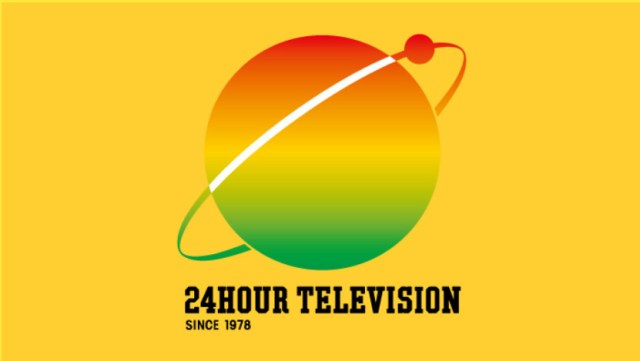
Could this 40-year-old, quintessential Japanese summer program be on its deathbed?
In Japan, 24-hour TV shows are big events, and in summer, none is bigger than Nippon TV’s “24-Hour Television”. It’s an annual, live charity telethon that, despite its name, often runs for more than 24 hours. The goal for each one is to raise money for domestic or international social welfare, environmental protection, or disaster relief and support, and it has been a staple of Japanese summer television for 40 years.
But the director of the production company in charge of the telethon says that Nippon TV executives should either be extremely embarrassed, or quaking in their boots, because the show is apparently struggling due to low donation rates, inappropriate spending, lack of celebrity interest, and a decrease in viewer popularity.
Over the last few years, donation amounts have been steadily decreasing. Last year’s donations, in fact, were more than 3 billion yen (US$27.2 million) lower than the average. Typically 24-Hour Television brings in about 10 billion yen in donations (more than US$90 million), and after the Great East Japan Earthquake and Tsunami in 2011, they raised an impressive 19 billion yen.
Sadly, though, last year’s donation didn’t even cap 7 billion yen, and the collections in 2015 and 2016 were also well under the 10 billion yen average. Apparently that’s due to the fact that an increasing percentage of donations were small-change donations instead of the larger donations received in previous years.
The problem of low donations is exacerbated by poor spending choices on the part of Nippon TV. Although they may have raised 7 billion yen, much of that was likely deducted for production expenses, some of which are allegedly extravagant. For example, the two MCs of last year’s show were paid 5 million yen (US$45,000) each, which seems a tad high, given that the entire point of the broadcast is to raise money for charity.
Not only that, but the Charity Run, which is a main component of the show, is also a significant money drain. In this marathon, a celebrity “volunteer” makes a sizeable donation and runs roughly 100 kilometers (62 miles) through Tokyo to the Budokan where the live show is filmed. But the “volunteer” is not actually a volunteer; they are, according to the director, paid about 10 million yen to run.
▼ Handycam footage of the 2012 runners, pro wrestler Keisuke Sasaki and family, making it to the end goal
Technically, they aren’t receiving “pay”, says the director; since the celebrities donate far more than they’re being paid. The salary they receive is also written off as “transportation expenses”, so, according to the books, they aren’t receiving anything they shouldn’t. But that seems like an oddly shifty way to go about accounting for a charity, and 10 million yen seems like an excessive amount of money for “transportation”.
Since Nippon TV is reportedly already paying 20 million yen to just three celebrities out of dozens that might appear, you can see how this suspicious spending is causing some controversy. In fact, when this information was released, the negative publicity spread like wildfire on social media, where many called the show hypocritical.
Because of this, many celebrities are rejecting offers to become the “Charity Runner”, citing it strange that they should get paid to participate in a fundraiser. Those that have accepted in recent years are one-hit wonders or new celebrities whose success may be thanks to their appearance on Nippon TV’s programming, and who, as a result, might find it more difficult to refuse.
Even fledgling celebrities are not interested in participating in this part of the show, though, because not only is it a truly difficult and time-consuming experience–they have to train with a marathon trainer for months before the airing of the show–, being the charity runner has come to have little value, even for newbies.
That’s in part thanks to the timing of the show–it’s on the weekend, which is the most lucrative time for celebrities, as it’s apparently when there are the most paying gigs. Celebrities can work at one or two sets on a Saturday and make more money, plus get better air time by appearing more than once on television. For those who are charity minded, they can later donate money in their private time, which is even better for their social image.
▼ A preview of this year’s 24-Hour Television, where popular Olympic ice skater Yuzuru Hanyu will apparently skate to Disney on Ice with children
24-Hour Television is even less appealing for celebrities because it is losing popularity among Japanese viewers. Many viewers these days dislike the show, which fills its more than 24 hours of content with emotionally charged drama specials, documentaries, and interviews with disaster victims or disadvantaged individuals. Some refer to it as “emotional porn”, since it capitalizes on sob stories and evoking emotional responses from viewers. Japanese viewers have already shown that they don’t like those kinds of segments, as revealed by a 2016 poll, which doesn’t bode well for the fate of the show.
▼ A segment about deaf children from the 2015 24-Hour Television, which is a good example of their typical heart-string-tugging media
24-Hour Television’s struggle to captivate audiences and gather donations, its shortage of willing celebrities, and its poor money management may lead the 40-year-old summer staple to its demise. Could it become another victim of a Japanese company’s refusal to adapt to changing markets and audiences, like the manga industry?
This year’s show, whose theme is “People who change lives”, and which will (hopefully) raise money for the flood-affected areas in Western Japan, will be aired live from 12 p.m. on August 25 to 7:20 p.m. on August 26. We’ll have to wait and see how this year’s show does to find out if it will survive to see another year.
Source: Yahoo! News via My Game News Flash
Top Image: 24 Hour Television
Insert Images: Pakutaso (1, 2, 3)




 Poll shows most disabled people in Japan dislike “inspirational” documentaries about disability
Poll shows most disabled people in Japan dislike “inspirational” documentaries about disability Egashira 2:50 donates 1M yen to flood-stricken parts of Japan
Egashira 2:50 donates 1M yen to flood-stricken parts of Japan J-rock star Yoshiki donates 10 million yen to coronavirus relief, asks everyone to stay home
J-rock star Yoshiki donates 10 million yen to coronavirus relief, asks everyone to stay home 16 facts about India that will blow your mind
16 facts about India that will blow your mind Yoshiki auctions off beloved crystal piano to support Noto Peninsula earthquake victims
Yoshiki auctions off beloved crystal piano to support Noto Peninsula earthquake victims How to order snacks on a Shinkansen bullet train in Japan
How to order snacks on a Shinkansen bullet train in Japan Burger King Japan suddenly adds Dr. Pepper and Dr. Pepper floats to its menu nationwide
Burger King Japan suddenly adds Dr. Pepper and Dr. Pepper floats to its menu nationwide New Nintendo Lego kit is a beautiful piece of moving pixel art of Mario and Yoshi【Photos】
New Nintendo Lego kit is a beautiful piece of moving pixel art of Mario and Yoshi【Photos】 Hello, cosmetics! Clinique teams up with Hello Kitty this summer for first-time collaboration
Hello, cosmetics! Clinique teams up with Hello Kitty this summer for first-time collaboration Demon Slayer: Kimetsu no Yaiba gets new roller coaster attractions and food at Universal Studios Japan
Demon Slayer: Kimetsu no Yaiba gets new roller coaster attractions and food at Universal Studios Japan 11 different ways to say “father” in Japanese
11 different ways to say “father” in Japanese Kyoto tea merchant’s matcha parfait ice cream bars: The desserts we’ve been waiting 187 years for
Kyoto tea merchant’s matcha parfait ice cream bars: The desserts we’ve been waiting 187 years for East meets West in the Pacific-centered version of the world map
East meets West in the Pacific-centered version of the world map What do you eat when you catch a cold? We asked 11 of our Japanese reporters
What do you eat when you catch a cold? We asked 11 of our Japanese reporters Shinjuku izakaya’s all-you-can-eat-and-drink plan is one of Tokyo’s best secret cheap eats
Shinjuku izakaya’s all-you-can-eat-and-drink plan is one of Tokyo’s best secret cheap eats Nintendo history you can feel – Super NES, N64, and GameCube controllers become capsule toys
Nintendo history you can feel – Super NES, N64, and GameCube controllers become capsule toys “The most Delicious Cup Noodle in history” – Japan’s French Cup Noodle wins our heart【Taste test】
“The most Delicious Cup Noodle in history” – Japan’s French Cup Noodle wins our heart【Taste test】 Starbucks releases a cute Frappuccino and Unicorn Cake…but not in Japan
Starbucks releases a cute Frappuccino and Unicorn Cake…but not in Japan Kyoto Tower mascot termination reveals dark side behind cute Japanese characters
Kyoto Tower mascot termination reveals dark side behind cute Japanese characters McDonald’s Japan’s Soft Twist Tower: A phantom ice cream only sold at select branches
McDonald’s Japan’s Soft Twist Tower: A phantom ice cream only sold at select branches Yabai Ramen: What makes this Japanese ramen so dangerous?
Yabai Ramen: What makes this Japanese ramen so dangerous? Finally! Nintendo Japan expands Switch 8-bit controller sales to everybody, Online member or not
Finally! Nintendo Japan expands Switch 8-bit controller sales to everybody, Online member or not Japanese government wants to build luxury resorts in all national parks for foreign tourists
Japanese government wants to build luxury resorts in all national parks for foreign tourists To combat declining birth rate, Japan to begin offering “Breeding Visas” to foreigners
To combat declining birth rate, Japan to begin offering “Breeding Visas” to foreigners 10 things you should buy at 7-Eleven in Japan
10 things you should buy at 7-Eleven in Japan Studio Ghibli releases anime heroine cosplay dresses that are super comfy to wear
Studio Ghibli releases anime heroine cosplay dresses that are super comfy to wear Woman charged for driving suitcase without a license in Osaka
Woman charged for driving suitcase without a license in Osaka Studio Ghibli unveils My Neighbour Totoro miniature house model
Studio Ghibli unveils My Neighbour Totoro miniature house model Kyoto experiencing problems with foreign tourists not paying for bus fares, but not on purpose
Kyoto experiencing problems with foreign tourists not paying for bus fares, but not on purpose Fighting mild hunger with a Japanese soda that turns into jelly in the stomach【Taste test】
Fighting mild hunger with a Japanese soda that turns into jelly in the stomach【Taste test】 Studio Ghibli’s Howl’s Moving Castle tapestry unveiled in Japan for first time
Studio Ghibli’s Howl’s Moving Castle tapestry unveiled in Japan for first time McDonald’s new Happy Meals offer up cute and practical Sanrio lifestyle goods
McDonald’s new Happy Meals offer up cute and practical Sanrio lifestyle goods Sales of Japan’s most convenient train ticket/shopping payment cards suspended indefinitely
Sales of Japan’s most convenient train ticket/shopping payment cards suspended indefinitely Sold-out Studio Ghibli desktop humidifiers are back so Totoro can help you through the dry season
Sold-out Studio Ghibli desktop humidifiers are back so Totoro can help you through the dry season Japanese government to make first change to romanization spelling rules since the 1950s
Japanese government to make first change to romanization spelling rules since the 1950s Foreigner’s request for help in Tokyo makes us sad for the state of society
Foreigner’s request for help in Tokyo makes us sad for the state of society Ghibli founders Toshio Suzuki and Hayao Miyazaki contribute to Japanese whisky Totoro label design
Ghibli founders Toshio Suzuki and Hayao Miyazaki contribute to Japanese whisky Totoro label design Doraemon found buried at sea as scene from 1993 anime becomes real life【Photos】
Doraemon found buried at sea as scene from 1993 anime becomes real life【Photos】 Tokyo’s most famous Starbucks is closed
Tokyo’s most famous Starbucks is closed Princesses, fruits, and blacksmiths: Study reveals the 30 most unusual family names in Japan
Princesses, fruits, and blacksmiths: Study reveals the 30 most unusual family names in Japan Get a soda and good karma with this donation-accepting vending machine
Get a soda and good karma with this donation-accepting vending machine Japan’s number-one cosplayer reveals her staggering earnings at this year’s Comiket
Japan’s number-one cosplayer reveals her staggering earnings at this year’s Comiket Tohoku tsunami survivor’s $12K camera: heart-felt gift or PR stunt?
Tohoku tsunami survivor’s $12K camera: heart-felt gift or PR stunt? Japanese wrestler Saori Yoshida smashes Guinness World Record by bursting balloons with her butt
Japanese wrestler Saori Yoshida smashes Guinness World Record by bursting balloons with her butt Kyoto Animation will use none of its arson donations for business recovery, all of it for victims
Kyoto Animation will use none of its arson donations for business recovery, all of it for victims Japanese public restroom ads donate to charities every time a stall is used
Japanese public restroom ads donate to charities every time a stall is used Is Asia missing the point of the ice bucket challenge? Taiwanese sufferer of ALS voices criticisms
Is Asia missing the point of the ice bucket challenge? Taiwanese sufferer of ALS voices criticisms Rakuten CEO donates one billion yen to Ukrainian humanitarian relief
Rakuten CEO donates one billion yen to Ukrainian humanitarian relief Kyoto Animation closing donation account for arson attack victims soon
Kyoto Animation closing donation account for arson attack victims soon Tweeters urge Japanese to donate to Serbian flood relief as repayment for Tōhoku support
Tweeters urge Japanese to donate to Serbian flood relief as repayment for Tōhoku support 70% of South Koreans will donate to fund for unity with North, want US and China to cough up too
70% of South Koreans will donate to fund for unity with North, want US and China to cough up too Japan is ranked the worst country in the world for helping strangers
Japan is ranked the worst country in the world for helping strangers A life-sized bust of Kenshiro from Fist of the North Star from Osaka is tax deductible!
A life-sized bust of Kenshiro from Fist of the North Star from Osaka is tax deductible! Japanese city offering authentic handcrafted swords in exchange for “tax” payments
Japanese city offering authentic handcrafted swords in exchange for “tax” payments World Heritage Site in Gunma struggling to crowdfund repair costs
World Heritage Site in Gunma struggling to crowdfund repair costs Ghibli Museum asking for donations from overseas fans to help it through hard times
Ghibli Museum asking for donations from overseas fans to help it through hard times
Leave a Reply